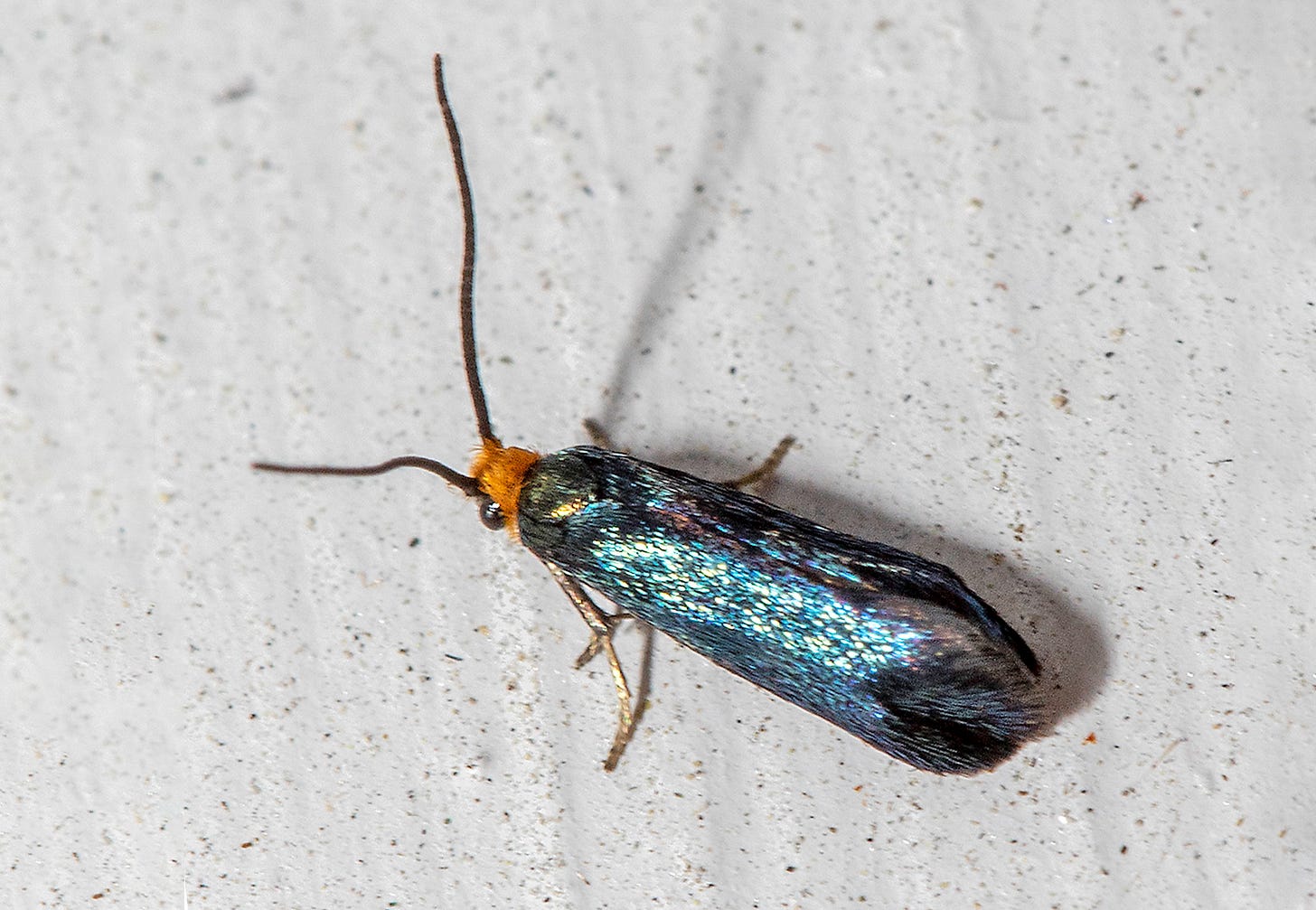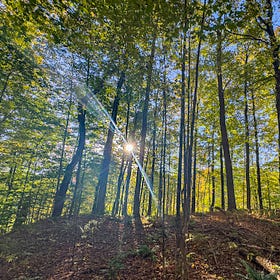This is the second in a three-part series about life falling to earth in autumn.
ALL SUMMER LONG a single maple leaf has been its food and the raw material for its shelter. Now I’ve turned that leaf into its stage. I give you a performance (with music) by the caterpillar of a Maple Leafcutter Moth.
I confess to forcing this performance on the unsuspecting caterpillar. At age 66, I aspire to be precocious and curious like a child in the woods. After all, in the ideas and exuberance of youth — digging, exploring, and getting dirty outside — we adults might learn a few things about joy and nature. Or at the very least, in my video below, we might be entertained by an otherwise unflappable caterpillar.
Even without the song and dance, the Maple Leafcutter Moth (Paraclemensia acerifoliella) is a performer. From an egg laid in spring by a metallic-blue adult moth, the caterpillar hatches and begins its summer of eating, growing, and shelter construction. With its chewing mouth parts, it cuts two discs from its maple leaf and stitches them together to form a larval case that resembles a green pita (which turns brown with age like the shelter in that image above). It’s a hideout from predators, mostly birds and other insects. From within its case, the Maple Leafcutter dines on the leaf upon which it rests. Although lots of moth and butterfly caterpillars can fold or roll themselves into a leaf for protection, this case construction is rare.
The Sugar Maple leaf below is a well-mined example of how this works. You can see holes where the Maple Leafcutters had cut out their shelter halves. The circular brown patches are where, from the safety of their cases, the caterpillars ate leaf tissue as they grew.
Most important to know for our purposes here together, the next image — of a case under construction — reveals a key characteristic of the shelter: one side is larger than the other. When inside its case on a leaf, a Maple Leafcutter wants the bigger side facing up. In that way, the caterpillar can poke its head just beyond the edge of the smaller, lower half and feed on the leaf surface while being protected by the overhang of the upper half. This inequality of halves is the source of our performance. (Well, actually, I’m the source, but you’ll soon see what I mean.)
I’d been noticing and writing about these caterpillars for decades before asking myself a simple question: What happens if the case is flipped over — by a breeze, for example, or a bird or after tumbling to another leaf? Can the Maple Leafcutter right its case (like a turtle) so that its larger side again faces up? This was an easy experiment — and a lot of fun. In the woods I began to flip caterpillar cases and watch what happened next. See for yourself (in 79 seconds)1:
VIDEO PENDING
In most instances, caterpillars righted their cases within two minutes. If I lost patience while waiting longer, I would often return to the scene a short time later to find the shelter turned larger-side-up. In each instance, the caterpillar would basically clasp the maple leaf surface and contort or gyrate its body as a lever for flipping its case.
A profound discovery on my part? Hardly. Caterpillar harassment? Well, maybe. More than anything, this was a matter of simple curiosity and an interaction (however contrived) with wildlife (however obscure). Rather than passing off this insect as just another little brown moth caterpillar in the woods, I momentarily inserted myself into its life.
We generally don’t achieve that kind of intimately with animals. More than merely a thing in the world — something to pass by on a leaf in the forest — an unbecoming caterpillar became an experience. And nature, including human nature, is nothing if not … you know … experiential. Kids intrinsically know this.
If you happen to be in the eastern U.S. and adjoining Canada, you might be able to take in this performance live for yourself this autumn. Maple Leafcutter Moth caterpillars are picky eaters. Find them mostly on Sugar Maples (Acer saccharum) and Black Maples (Acer nigrum), including on waist-high saplings for easy viewing. (Here’s an iNaturalist map of sightings.) I occasionally find them on other maple species and on American Beech (Fagus grandifolia).
Before I wrap up, recall that this dispatch is second in a series about life falling to earth. (The first featured autumn leaves and election season.) At my home in north-central Vermont this week, the fall foliage is at peak color — truly magnificent. None of us here is immune to the beauty — not the grizzled logger, the worried voter, the distracted banker, the aging and childlike eco-writer. If we know what’s good for us, we stop often to gasp and sigh at the hues. And even as we Vermonters sometimes debate (like art critics) the quality of the foliage during any given autumn — whether it’s muted, for example, or too green, or not red enough — here’s the thing about autumn in Vermont: It’s ALWAYS beautiful. (So no complaining about the foliage — ever.)
As I pointed out last week, leaf by falling leaf, autumn is the genuine trickle-down economics: a transfer of wealth from forest canopy to earth. That includes Maple Leafcutter Moth caterpillars in their cases. They’re now falling with leaves or falling on their own. Once at rest on the forest floor, still within its case, each caterpillar will weave a silken cocoon and become a pupa. Then a miracle of metamorphosis: a crawling, chewing, case-building (and flipping) caterpillar transforms itself into a metallic-blue moth with a jaunty orange head. They emerge in spring to take flight, mate, and find brand new maple leaves on which the female will lay her eggs. A cycle begins anew.
And if I’m fortunate enough to join that cycle once again next summer, I’ll be that exuberant kid in the woods flipping over little caterpillar cases along the way.
Postscripts and References
One other very cool thing: If blown or otherwise knocked prematurely from its leaf to the ground, a Maple Leafcutter caterpillar will climb back up the tree in its case to find another leaf in order to keep feeding. (That was probably the situation in my banner image at the top of this essay.)
Another wonderful thing is that insect lives are usually way more complex than we might know (or I might even write for you). So here is more complete account (with photos) of Maple Leafcutter’s life cycle — from egg to adult.
“Bionomics of the Maple Leaf Cutter, Paraclemensia acerifoliella (Fitch), (Lepidoptera: Incurvariidae)” by D.A. Ross. The Canadian Entomologist, Volume 94, Number 10. October 1962.
“Paraclemensia acerifoliella (Lepidoptera: Incurvariidae) in western Canada: A newly discovered host, an expanded range, and biogeographical considerations” by Gregory R. Pohl, Christi Jaeger, Vazrick Nazari, Chris Schmidt, Danika Richard, Stan Gosche. The Canadian Entomologist. December 2014.
Special thanks to my inquisitive colleagues: Nona Estrin, Shelby Perry, and especially Trish Hanson, who first helped me discover these insects (and many others) about 30 years ago.










This video is not helping my current Substack addiction. Pure gold.
The music was perfect!! It had me chuckling all the way to the crescendo!